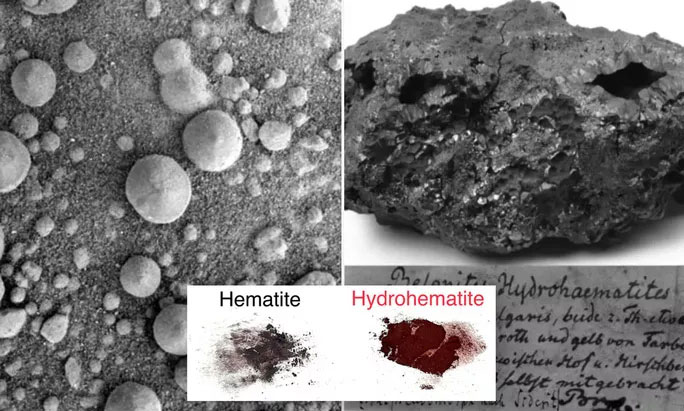'Mars creature' is something that appeared on Earth in the 19th century?
Objects in NASA's early images of the surface of Mars - round structures thought to be lower organisms, others to be rocks - may be hydrohematite.
New research led by the Smithsonian Institution (Germany) and Pennsylvania State University (USA) says that the circular masses on the Martian surface may be hydrohematite , which was discovered by German miner August Breithaupt. in 1843, right on Earth.
According to the Daily Mail, this rock is a hydrated form of iron mineral and it is iron that gives it its characteristic red color.

The "strange object" in the NASA photo and similar rock mass was found right on Earth - (Image: Smithsonian Institution).
In this study, scientists re-analyzed old rock samples, including using infrared spectroscopy and X-ray diffraction to "closely look" at the components. They found that in an alkaline environment, water, and the right temperature, hydrohematite can precipitate out, forming deposits.
That was the condition of ancient Mars, when the planet was not as dry as it is now. Considering the components of Martian soil that Curiosity - NASA's rover, which has been on Mars for many years - has collected, they believe that the circular masses in the NASA image are hydrohematite. Earth's hydrohematite clumps are thought to have also formed in situ, but because few regions of the Earth have conditions suitable for this mineral as on Mars, it is less common.
This mineral's abundant occurrence also helps explain the planet's characteristic red color. If it is indeed hydrohematite, it will be great news for cosmologists because hydromematite is very hydrated, and will be a significant resource for Martian bases, according to Space .
The NASA photo, taken by Curiostity, has led to a flurry of speculation and research. Most call it "blueberry ice" because it is believed to be a rock but is shaped like a blueberry. However, many researchers believe that it is an organism of Mars - a lower organism similar to mushrooms on Earth, because through many photos, they appear to change.
- The life of people in the bottom of society in London in the 19th century
- The life of Saigon in the 19th century through pictures
- 19th century China through rare photos
- Objects similar to smartphones in the 19th century painting
- Rare photos of British colonial India in the 19th century
- The weirdest series of images taken on Mars
- Detecting 'ghost dust' on red planet
- Photos of life in China in the late 19th century
- What do you know about 19th-century television with
- Discovered two missing ships from the 19th century when searching for MH370
- Modern people are not as intelligent as people of the 19th century?
- Unexpectedly discovered the mysterious 19th century shipwreck in the Gulf of Mexico
 Announced 3 houses on the Moon and Mars
Announced 3 houses on the Moon and Mars Science proves: Mars also knows 'deflated'
Science proves: Mars also knows 'deflated' Elon Musk announced the price for a Mars trip was 11.6 billion VND, free of charge
Elon Musk announced the price for a Mars trip was 11.6 billion VND, free of charge NASA discovered strange 'gate' on Mars, is the hiding place found?
NASA discovered strange 'gate' on Mars, is the hiding place found?